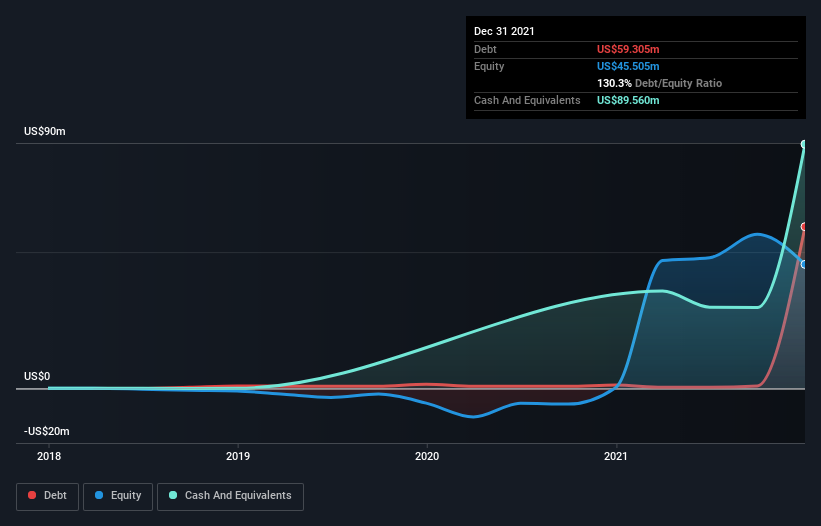GreenBox POS (NASDAQ:GBOX) Is Using Debt Safely
Some say volatility, rather than debt, is the best way to think about risk as an investor, but Warren Buffett famously said that 'Volatility is far from synonymous with risk.' When we think about how risky a company is, we always like to look at its use of debt, since debt overload can lead to ruin. As with many other companies GreenBox POS (NASDAQ:GBOX) makes use of debt. But is this debt a concern to shareholders?
When Is Debt A Problem?
Debt assists a business until the business has trouble paying it off, either with new capital or with free cash flow. Ultimately, if the company can't fulfill its legal obligations to repay debt, shareholders could walk away with nothing. However, a more common (but still painful) scenario is that it has to raise new equity capital at a low price, thus permanently diluting shareholders. Of course, debt can be an important tool in businesses, particularly capital heavy businesses. When we examine debt levels, we first consider both cash and debt levels, together.
See our latest analysis for GreenBox POS
What Is GreenBox POS's Net Debt?
As you can see below, at the end of December 2021, GreenBox POS had US$59.3m of debt, up from US$1.28m a year ago. Click the image for more detail. But it also has US$89.6m in cash to offset that, meaning it has US$30.3m net cash.
A Look At GreenBox POS' Liabilities
According to the last reported balance sheet, GreenBox POS had liabilities of US$26.8m due within 12 months, and liabilities of US$60.3m due beyond 12 months. On the other hand, it had cash of US$89.6m and US$19.4m worth of receivables due within a year. So it can boast US$21.8m more liquid assets than total liabilities.
This excess liquidity suggests that GreenBox POS is taking a careful approach to debt. Given it has easily adequate short term liquidity, we don't think it will have any issues with its lenders. Simply put, the fact that GreenBox POS has more cash than debt is arguably a good indication that it can manage its debt safely. When analysing debt levels, the balance sheet is the obvious place to start. But it is future earnings, more than anything, that will determine GreenBox POS's ability to maintain a healthy balance sheet going forward. So if you want to see what the professionals think, you might find this free report on analyst profit forecasts to be interesting.
Over 12 months, GreenBox POS reported revenue of US$26m, which is a gain of 209%, although it did not report any earnings before interest and tax. That's virtually the hole-in-one of revenue growth!
So How Risky Is GreenBox POS?
By their very nature companies that are losing money are more risky than those with a long history of profitability. And in the last year GreenBox POS had an earnings before interest and tax (EBIT) loss, truth be told. And over the same period it saw negative free cash outflow of US$27m and booked a US$26m accounting loss. With only US$30.3m on the balance sheet, it would appear that its going to need to raise capital again soon. The good news for shareholders is that GreenBox POS has dazzling revenue growth, so there's a very good chance it can boost its free cash flow in the years to come. While unprofitable companies can be risky, they can also grow hard and fast in those pre-profit years. When analysing debt levels, the balance sheet is the obvious place to start. But ultimately, every company can contain risks that exist outside of the balance sheet. For instance, we've identified 3 warning signs for GreenBox POS that you should be aware of.
If, after all that, you're more interested in a fast growing company with a rock-solid balance sheet, then check out our list of net cash growth stocks without delay.
Have feedback on this article? Concerned about the content? Get in touch with us directly. Alternatively, email editorial-team (at) simplywallst.com.
This article by Simply Wall St is general in nature. We provide commentary based on historical data and analyst forecasts only using an unbiased methodology and our articles are not intended to be financial advice. It does not constitute a recommendation to buy or sell any stock, and does not take account of your objectives, or your financial situation. We aim to bring you long-term focused analysis driven by fundamental data. Note that our analysis may not factor in the latest price-sensitive company announcements or qualitative material. Simply Wall St has no position in any stocks mentioned.



